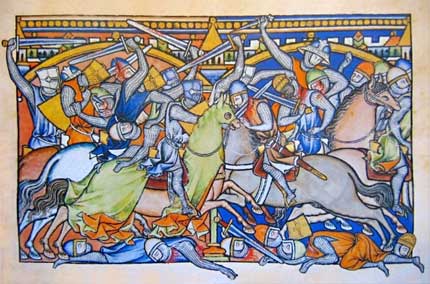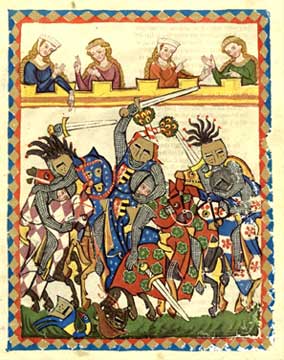As a brief definition, Heraldry is an auxiliary science of History that studies, describes and defines the Coats of Arms, escutcheons and shields, constituting these by emblems with characteristics and own rules, colored or black and white, referring to a person, institution or community.
The King of Arms or Royal Herald is a court official responsible for the registration and compilation of the armorial bearings. He has also the responsibility of study and develop new coats of arms, being the maximum responsible for the observance and fulfillment of the heraldic laws.

The figure represents Thomas Hawley, the King of Arms of the College of Arms
of London, represented in a chapter of an English letter of arms, dated 1556.
ORIGINS OF THE HERALDRY
Heraldry, whose origins date back to the 12nd century, emerged in western Europe linked to war and the development of military equipment. But it was mostly with the growth of the tournaments, jousts and festivals, that Heraldry had a great impulse, having been widely spread by Europe. To distinguish themselves and to be recognized, whether in battles or tournaments, the medieval knights began to display their military equipment – specially the shields – with an original system of identification composed by simple and geometrical figures of gaudy colors. We must not forget that at that time the helmets covered almost the whole face of a knight, making him virtually impossible to be identified on the battlefield. Initially these figures were simple and stylized so that their bearer could be easily recognized afar. The drawings could display geometric figures, real or fantastic animals or to be floral inspired. Over time these symbols became more elaborate and passed on to subsequent generations, representing not only the family or lineage of the one who bore it, but also the status of the new rising social class: the knights.

Above, the representation of a medieval battle.

The image below reproduces a medieval tournament, with the knights boasting profuse
heraldic representations on their robes, shields and in the fabrics that covers the horses.
Although there are several theories about the origins of Heraldry, some more fanciful than others, scholars today agree that its appearing is related to the transformation of feudal society after the Thousand Year, as well as with the evolution of military equipment between the eleventh century and the first decades of the twelfth century.
Heraldry is considered an auxiliary science of history and it can be classified into several categories: Family, Civic (cities, towns, parishes), Ecclesiastical (dioceses and clerical hierarchy), Military and Corporate.